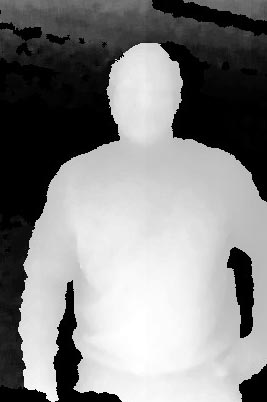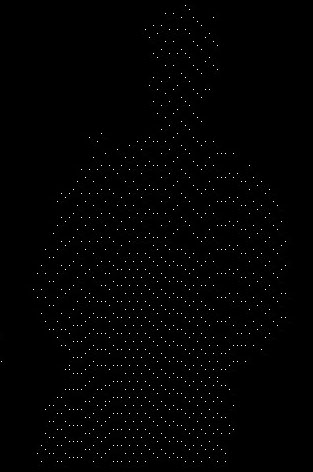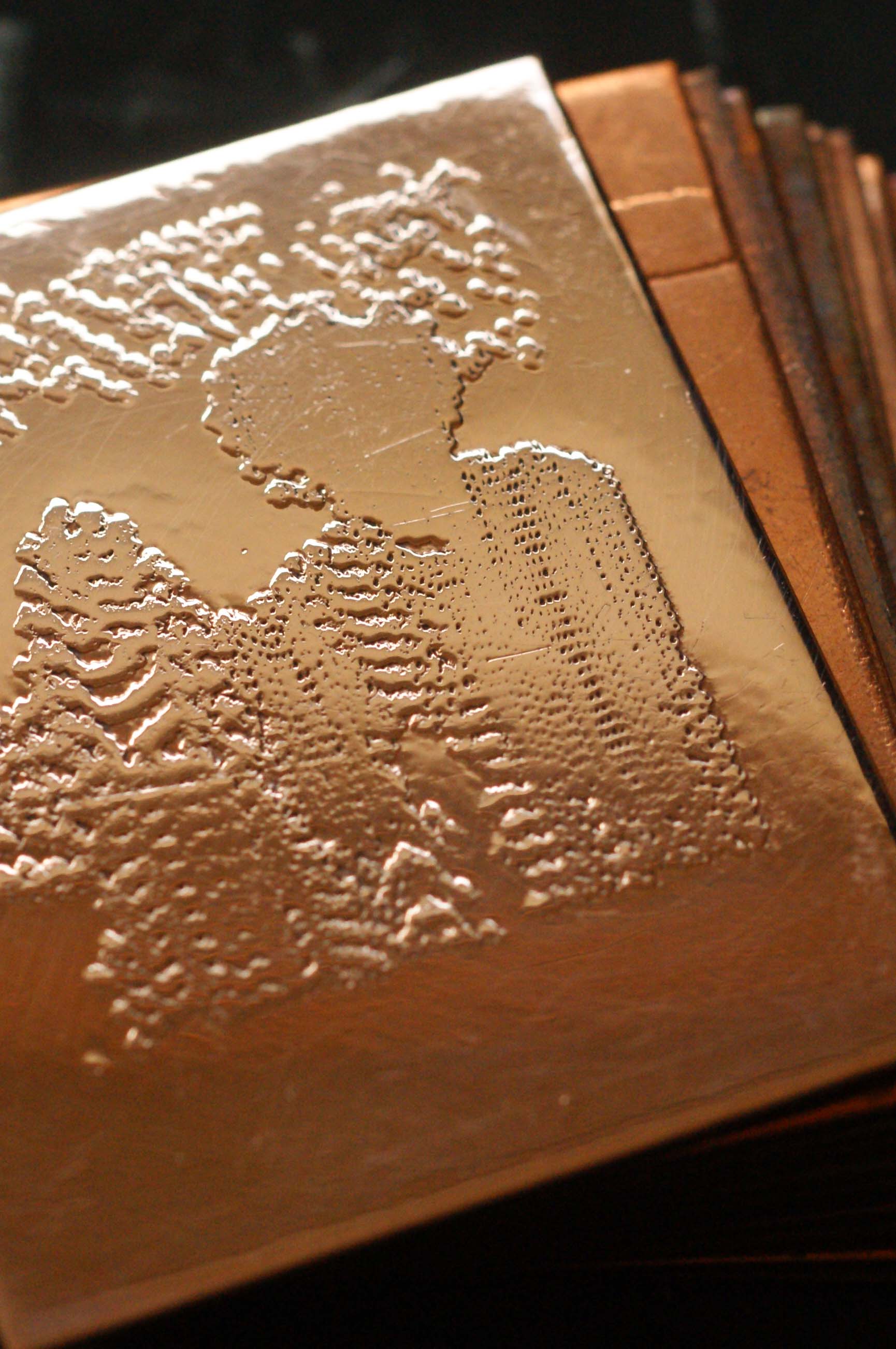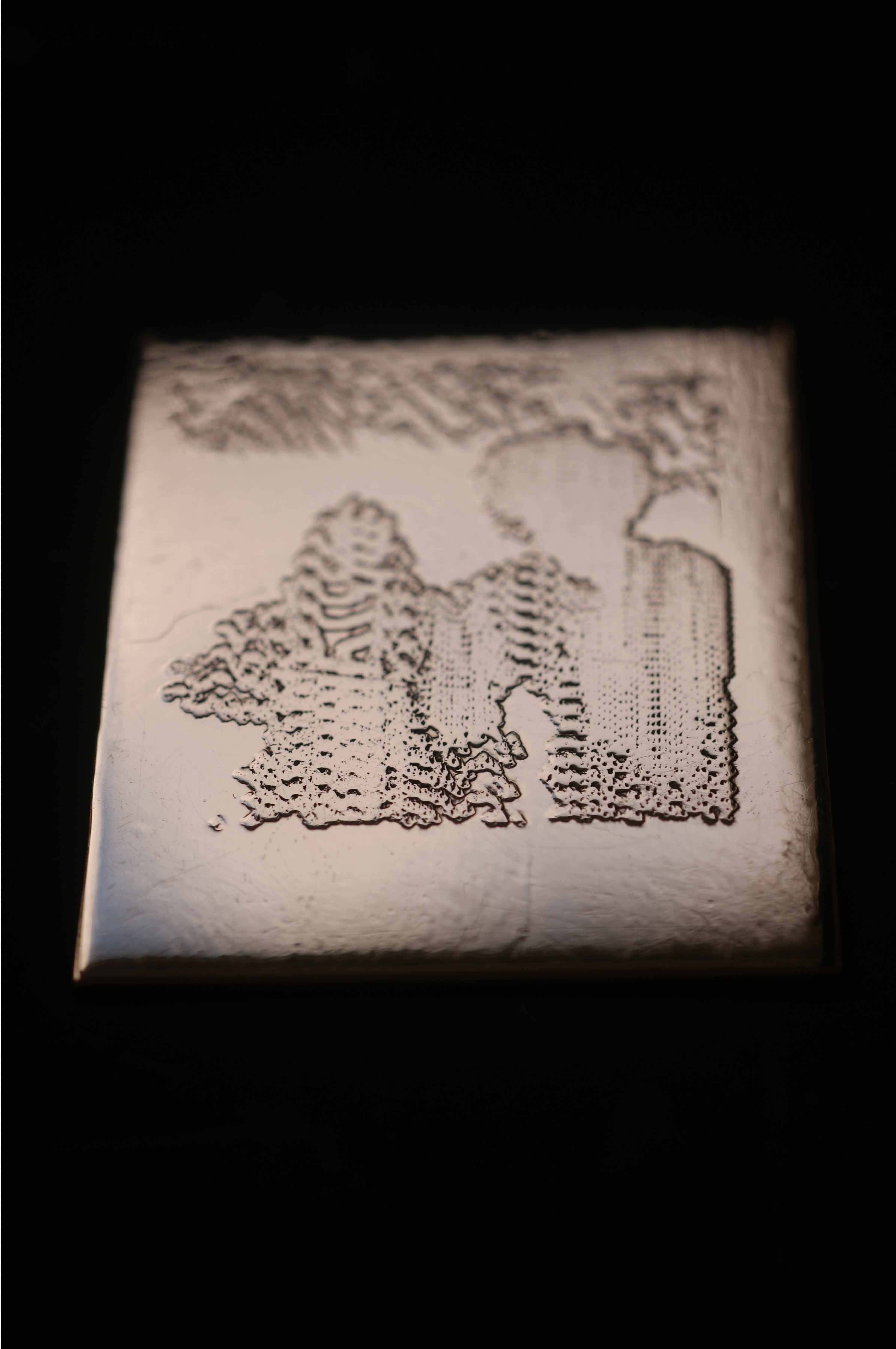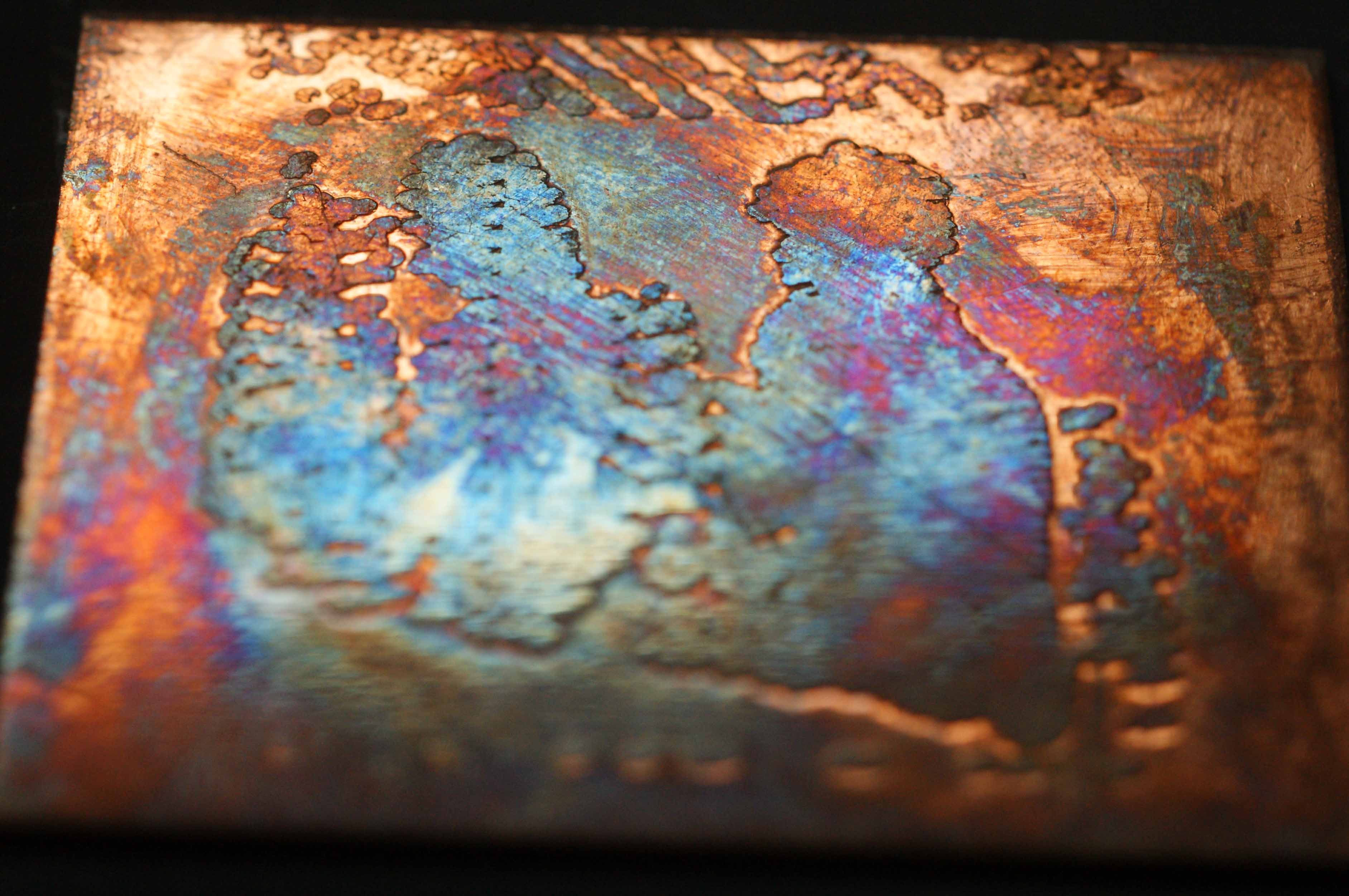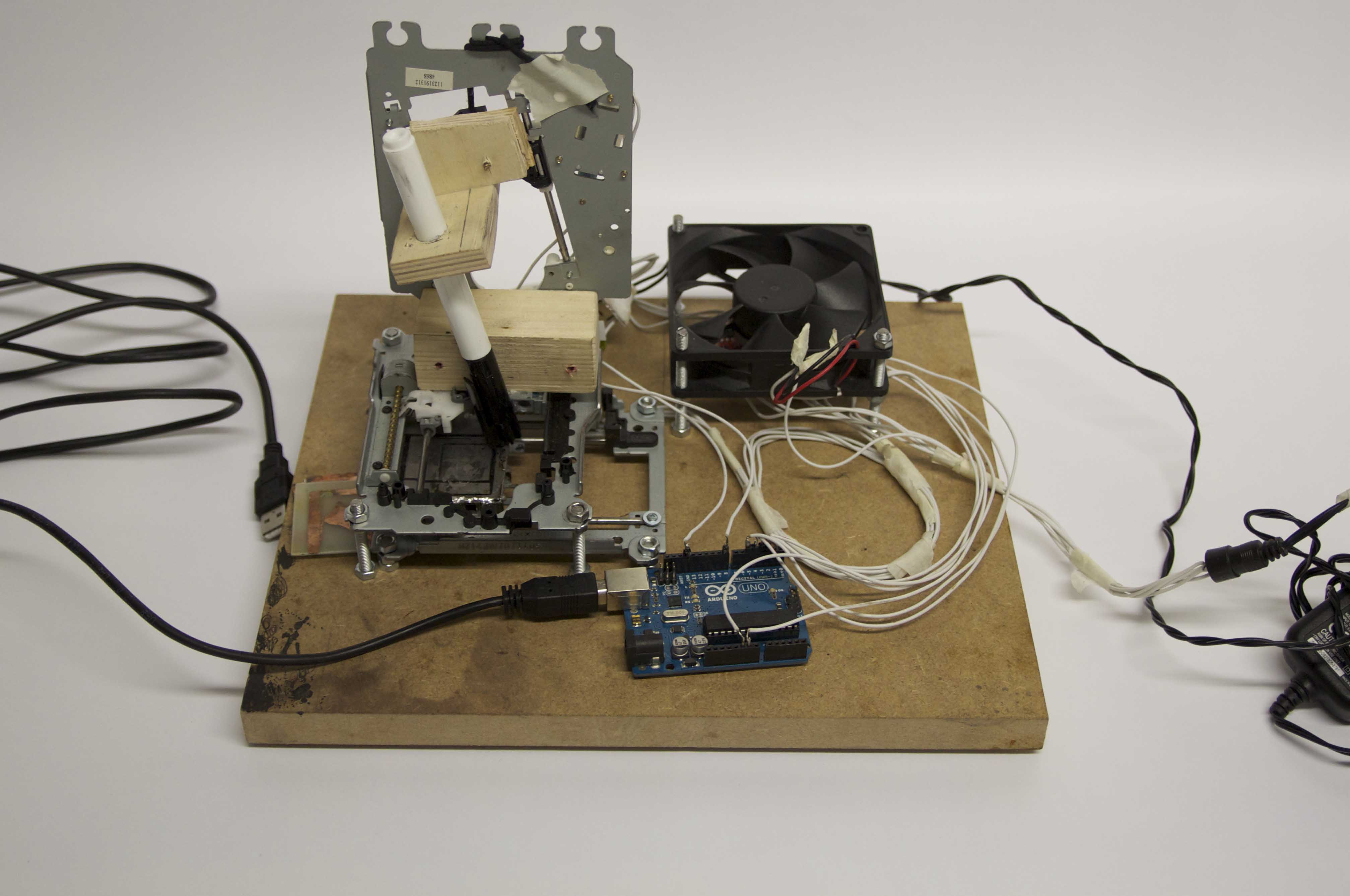
Unbreakable Polaroid
Since the printer can only print depth and no color I couldn't use a normal camera, therefore I used a Kinect sensor as input. The Kinect has the ability to make a depth image and only capture a object standing a certain distance from the camera, rendering the back and foreground invisible. This made the printing a lot easier. The grayscale output image from the sensor was dithered in order to give it some field of depth. The camera printed this image using a dot-matrix printer and a water-resistant marker. After the printing process the image has to be developed in a Iron(III) chloride solution. This acid etches the copper on all the places where there isn't any marker. After five minutes the process is done and the photo can be rinsed, cleaned and polished.
Unbreakable Polaroid
Since the printer can only print depth and no color I couldn't use a normal camera, therefore I used a Kinect sensor as input. The Kinect has the ability to make a depth image and only capture a object standing a certain distance from the camera, rendering the back and foreground invisible. This made the printing a lot easier. The grayscale output image from the sensor was dithered in order to give it some field of depth. The camera printed this image using a dot-matrix printer and a water-resistant marker. After the printing process the image has to be developed in a Iron(III) chloride solution. This acid etches the copper on all the places where there isn't any marker. After five minutes the process is done and the photo can be rinsed, cleaned and polished.
Unbreakable Polaroid
Since the printer can only print depth and no color I couldn't use a normal camera, therefore I used a Kinect sensor as input. The Kinect has the ability to make a depth image and only capture a object standing a certain distance from the camera, rendering the back and foreground invisible. This made the printing a lot easier. The grayscale output image from the sensor was dithered in order to give it some field of depth. The camera printed this image using a dot-matrix printer and a water-resistant marker. After the printing process the image has to be developed in a Iron(III) chloride solution. This acid etches the copper on all the places where there isn't any marker. After five minutes the process is done and the photo can be rinsed, cleaned and polished.
Unbreakable Polaroid
Since the printer can only print depth and no color I couldn't use a normal camera, therefore I used a Kinect sensor as input. The Kinect has the ability to make a depth image and only capture a object standing a certain distance from the camera, rendering the back and foreground invisible. This made the printing a lot easier. The grayscale output image from the sensor was dithered in order to give it some field of depth. The camera printed this image using a dot-matrix printer and a water-resistant marker. After the printing process the image has to be developed in a Iron(III) chloride solution. This acid etches the copper on all the places where there isn't any marker. After five minutes the process is done and the photo can be rinsed, cleaned and polished.
Unbreakable Polaroid
Since the printer can only print depth and no color I couldn't use a normal camera, therefore I used a Kinect sensor as input. The Kinect has the ability to make a depth image and only capture a object standing a certain distance from the camera, rendering the back and foreground invisible. This made the printing a lot easier. The grayscale output image from the sensor was dithered in order to give it some field of depth. The camera printed this image using a dot-matrix printer and a water-resistant marker. After the printing process the image has to be developed in a Iron(III) chloride solution. This acid etches the copper on all the places where there isn't any marker. After five minutes the process is done and the photo can be rinsed, cleaned and polished.
Unbreakable Polaroid
Since the printer can only print depth and no color I couldn't use a normal camera, therefore I used a Kinect sensor as input. The Kinect has the ability to make a depth image and only capture a object standing a certain distance from the camera, rendering the back and foreground invisible. This made the printing a lot easier. The grayscale output image from the sensor was dithered in order to give it some field of depth. The camera printed this image using a dot-matrix printer and a water-resistant marker. After the printing process the image has to be developed in a Iron(III) chloride solution. This acid etches the copper on all the places where there isn't any marker. After five minutes the process is done and the photo can be rinsed, cleaned and polished.
Unbreakable Polaroid
Since the printer can only print depth and no color I couldn't use a normal camera, therefore I used a Kinect sensor as input. The Kinect has the ability to make a depth image and only capture a object standing a certain distance from the camera, rendering the back and foreground invisible. This made the printing a lot easier. The grayscale output image from the sensor was dithered in order to give it some field of depth. The camera printed this image using a dot-matrix printer and a water-resistant marker. After the printing process the image has to be developed in a Iron(III) chloride solution. This acid etches the copper on all the places where there isn't any marker. After five minutes the process is done and the photo can be rinsed, cleaned and polished.
Unbreakable Polaroid
Since the printer can only print depth and no color I couldn't use a normal camera, therefore I used a Kinect sensor as input. The Kinect has the ability to make a depth image and only capture a object standing a certain distance from the camera, rendering the back and foreground invisible. This made the printing a lot easier. The grayscale output image from the sensor was dithered in order to give it some field of depth. The camera printed this image using a dot-matrix printer and a water-resistant marker. After the printing process the image has to be developed in a Iron(III) chloride solution. This acid etches the copper on all the places where there isn't any marker. After five minutes the process is done and the photo can be rinsed, cleaned and polished.
Unbreakable Polaroid
Since the printer can only print depth and no color I couldn't use a normal camera, therefore I used a Kinect sensor as input. The Kinect has the ability to make a depth image and only capture a object standing a certain distance from the camera, rendering the back and foreground invisible. This made the printing a lot easier. The grayscale output image from the sensor was dithered in order to give it some field of depth. The camera printed this image using a dot-matrix printer and a water-resistant marker. After the printing process the image has to be developed in a Iron(III) chloride solution. This acid etches the copper on all the places where there isn't any marker. After five minutes the process is done and the photo can be rinsed, cleaned and polished.
Unbreakable Polaroid
Since the printer can only print depth and no color I couldn't use a normal camera, therefore I used a Kinect sensor as input. The Kinect has the ability to make a depth image and only capture a object standing a certain distance from the camera, rendering the back and foreground invisible. This made the printing a lot easier. The grayscale output image from the sensor was dithered in order to give it some field of depth. The camera printed this image using a dot-matrix printer and a water-resistant marker. After the printing process the image has to be developed in a Iron(III) chloride solution. This acid etches the copper on all the places where there isn't any marker. After five minutes the process is done and the photo can be rinsed, cleaned and polished.
Unbreakable Polaroid
Since the printer can only print depth and no color I couldn't use a normal camera, therefore I used a Kinect sensor as input. The Kinect has the ability to make a depth image and only capture a object standing a certain distance from the camera, rendering the back and foreground invisible. This made the printing a lot easier. The grayscale output image from the sensor was dithered in order to give it some field of depth. The camera printed this image using a dot-matrix printer and a water-resistant marker. After the printing process the image has to be developed in a Iron(III) chloride solution. This acid etches the copper on all the places where there isn't any marker. After five minutes the process is done and the photo can be rinsed, cleaned and polished.
Unbreakable Polaroid
Since the printer can only print depth and no color I couldn't use a normal camera, therefore I used a Kinect sensor as input. The Kinect has the ability to make a depth image and only capture a object standing a certain distance from the camera, rendering the back and foreground invisible. This made the printing a lot easier. The grayscale output image from the sensor was dithered in order to give it some field of depth. The camera printed this image using a dot-matrix printer and a water-resistant marker. After the printing process the image has to be developed in a Iron(III) chloride solution. This acid etches the copper on all the places where there isn't any marker. After five minutes the process is done and the photo can be rinsed, cleaned and polished.
Unbreakable Polaroid
Since the printer can only print depth and no color I couldn't use a normal camera, therefore I used a Kinect sensor as input. The Kinect has the ability to make a depth image and only capture a object standing a certain distance from the camera, rendering the back and foreground invisible. This made the printing a lot easier. The grayscale output image from the sensor was dithered in order to give it some field of depth. The camera printed this image using a dot-matrix printer and a water-resistant marker. After the printing process the image has to be developed in a Iron(III) chloride solution. This acid etches the copper on all the places where there isn't any marker. After five minutes the process is done and the photo can be rinsed, cleaned and polished.
Unbreakable Polaroid
Since the printer can only print depth and no color I couldn't use a normal camera, therefore I used a Kinect sensor as input. The Kinect has the ability to make a depth image and only capture a object standing a certain distance from the camera, rendering the back and foreground invisible. This made the printing a lot easier. The grayscale output image from the sensor was dithered in order to give it some field of depth. The camera printed this image using a dot-matrix printer and a water-resistant marker. After the printing process the image has to be developed in a Iron(III) chloride solution. This acid etches the copper on all the places where there isn't any marker. After five minutes the process is done and the photo can be rinsed, cleaned and polished.
Unbreakable Polaroid
Since the printer can only print depth and no color I couldn't use a normal camera, therefore I used a Kinect sensor as input. The Kinect has the ability to make a depth image and only capture a object standing a certain distance from the camera, rendering the back and foreground invisible. This made the printing a lot easier. The grayscale output image from the sensor was dithered in order to give it some field of depth. The camera printed this image using a dot-matrix printer and a water-resistant marker. After the printing process the image has to be developed in a Iron(III) chloride solution. This acid etches the copper on all the places where there isn't any marker. After five minutes the process is done and the photo can be rinsed, cleaned and polished.
Unbreakable Polaroid
Since the printer can only print depth and no color I couldn't use a normal camera, therefore I used a Kinect sensor as input. The Kinect has the ability to make a depth image and only capture a object standing a certain distance from the camera, rendering the back and foreground invisible. This made the printing a lot easier. The grayscale output image from the sensor was dithered in order to give it some field of depth. The camera printed this image using a dot-matrix printer and a water-resistant marker. After the printing process the image has to be developed in a Iron(III) chloride solution. This acid etches the copper on all the places where there isn't any marker. After five minutes the process is done and the photo can be rinsed, cleaned and polished.
Unbreakable Polaroid
Since the printer can only print depth and no color I couldn't use a normal camera, therefore I used a Kinect sensor as input. The Kinect has the ability to make a depth image and only capture a object standing a certain distance from the camera, rendering the back and foreground invisible. This made the printing a lot easier. The grayscale output image from the sensor was dithered in order to give it some field of depth. The camera printed this image using a dot-matrix printer and a water-resistant marker. After the printing process the image has to be developed in a Iron(III) chloride solution. This acid etches the copper on all the places where there isn't any marker. After five minutes the process is done and the photo can be rinsed, cleaned and polished.
Unbreakable Polaroid
Since the printer can only print depth and no color I couldn't use a normal camera, therefore I used a Kinect sensor as input. The Kinect has the ability to make a depth image and only capture a object standing a certain distance from the camera, rendering the back and foreground invisible. This made the printing a lot easier. The grayscale output image from the sensor was dithered in order to give it some field of depth. The camera printed this image using a dot-matrix printer and a water-resistant marker. After the printing process the image has to be developed in a Iron(III) chloride solution. This acid etches the copper on all the places where there isn't any marker. After five minutes the process is done and the photo can be rinsed, cleaned and polished.
Unbreakable Polaroid
Since the printer can only print depth and no color I couldn't use a normal camera, therefore I used a Kinect sensor as input. The Kinect has the ability to make a depth image and only capture a object standing a certain distance from the camera, rendering the back and foreground invisible. This made the printing a lot easier. The grayscale output image from the sensor was dithered in order to give it some field of depth. The camera printed this image using a dot-matrix printer and a water-resistant marker. After the printing process the image has to be developed in a Iron(III) chloride solution. This acid etches the copper on all the places where there isn't any marker. After five minutes the process is done and the photo can be rinsed, cleaned and polished.
Unbreakable Polaroid
Since the printer can only print depth and no color I couldn't use a normal camera, therefore I used a Kinect sensor as input. The Kinect has the ability to make a depth image and only capture a object standing a certain distance from the camera, rendering the back and foreground invisible. This made the printing a lot easier. The grayscale output image from the sensor was dithered in order to give it some field of depth. The camera printed this image using a dot-matrix printer and a water-resistant marker. After the printing process the image has to be developed in a Iron(III) chloride solution. This acid etches the copper on all the places where there isn't any marker. After five minutes the process is done and the photo can be rinsed, cleaned and polished.
Unbreakable Polaroid
Since the printer can only print depth and no color I couldn't use a normal camera, therefore I used a Kinect sensor as input. The Kinect has the ability to make a depth image and only capture a object standing a certain distance from the camera, rendering the back and foreground invisible. This made the printing a lot easier. The grayscale output image from the sensor was dithered in order to give it some field of depth. The camera printed this image using a dot-matrix printer and a water-resistant marker. After the printing process the image has to be developed in a Iron(III) chloride solution. This acid etches the copper on all the places where there isn't any marker. After five minutes the process is done and the photo can be rinsed, cleaned and polished.
Unbreakable Polaroid
Since the printer can only print depth and no color I couldn't use a normal camera, therefore I used a Kinect sensor as input. The Kinect has the ability to make a depth image and only capture a object standing a certain distance from the camera, rendering the back and foreground invisible. This made the printing a lot easier. The grayscale output image from the sensor was dithered in order to give it some field of depth. The camera printed this image using a dot-matrix printer and a water-resistant marker. After the printing process the image has to be developed in a Iron(III) chloride solution. This acid etches the copper on all the places where there isn't any marker. After five minutes the process is done and the photo can be rinsed, cleaned and polished.
Unbreakable Polaroid
Since the printer can only print depth and no color I couldn't use a normal camera, therefore I used a Kinect sensor as input. The Kinect has the ability to make a depth image and only capture a object standing a certain distance from the camera, rendering the back and foreground invisible. This made the printing a lot easier. The grayscale output image from the sensor was dithered in order to give it some field of depth. The camera printed this image using a dot-matrix printer and a water-resistant marker. After the printing process the image has to be developed in a Iron(III) chloride solution. This acid etches the copper on all the places where there isn't any marker. After five minutes the process is done and the photo can be rinsed, cleaned and polished.
Unbreakable Polaroid
Since the printer can only print depth and no color I couldn't use a normal camera, therefore I used a Kinect sensor as input. The Kinect has the ability to make a depth image and only capture a object standing a certain distance from the camera, rendering the back and foreground invisible. This made the printing a lot easier. The grayscale output image from the sensor was dithered in order to give it some field of depth. The camera printed this image using a dot-matrix printer and a water-resistant marker. After the printing process the image has to be developed in a Iron(III) chloride solution. This acid etches the copper on all the places where there isn't any marker. After five minutes the process is done and the photo can be rinsed, cleaned and polished.
Tags
Dot-matrix
Printer
Copper
Etching
Kinect
Hacking
CD-tray
Dot-matrix
Printer
Copper
Etching
Kinect
Hacking
CD-tray
Media
Installation
Installation
Subject
Interaction Design
Interaction Design
Year
2016
2016
Tags
Dot-matrix
Printer
Copper
Etching
Kinect
Hacking
CD-tray
Dot-matrix
Printer
Copper
Etching
Kinect
Hacking
CD-tray
Media
Installation
Installation
Subject
Interaction Design
Interaction Design
Year
2016
2016
Tags
Dot-matrix
Printer
Copper
Etching
Kinect
Hacking
CD-tray
Dot-matrix
Printer
Copper
Etching
Kinect
Hacking
CD-tray
Media
Installation
Installation
Subject
Interaction Design
Interaction Design
Year
2016
2016
Tags
Dot-matrix
Printer
Copper
Etching
Kinect
Hacking
CD-tray
Dot-matrix
Printer
Copper
Etching
Kinect
Hacking
CD-tray
Media
Installation
Installation
Subject
Interaction Design
Interaction Design
Year
2016
2016
Tags
Dot-matrix
Printer
Copper
Etching
Kinect
Hacking
CD-tray
Dot-matrix
Printer
Copper
Etching
Kinect
Hacking
CD-tray
Media
Installation
Installation
Subject
Interaction Design
Interaction Design
Year
2016
2016
Tags
Dot-matrix
Printer
Copper
Etching
Kinect
Hacking
CD-tray
Dot-matrix
Printer
Copper
Etching
Kinect
Hacking
CD-tray
Media
Installation
Installation
Subject
Interaction Design
Interaction Design
Year
2016
2016
Tags
Dot-matrix
Printer
Copper
Etching
Kinect
Hacking
CD-tray
Dot-matrix
Printer
Copper
Etching
Kinect
Hacking
CD-tray
Media
Installation
Installation
Subject
Interaction Design
Interaction Design
Year
2016
2016
Tags
Dot-matrix
Printer
Copper
Etching
Kinect
Hacking
CD-tray
Dot-matrix
Printer
Copper
Etching
Kinect
Hacking
CD-tray
Media
Installation
Installation
Subject
Interaction Design
Interaction Design
Year
2016
2016
Tags
Dot-matrix
Printer
Copper
Etching
Kinect
Hacking
CD-tray
Dot-matrix
Printer
Copper
Etching
Kinect
Hacking
CD-tray
Media
Installation
Installation
Subject
Interaction Design
Interaction Design
Year
2016
2016
Tags
Dot-matrix
Printer
Copper
Etching
Kinect
Hacking
CD-tray
Dot-matrix
Printer
Copper
Etching
Kinect
Hacking
CD-tray
Media
Installation
Installation
Subject
Interaction Design
Interaction Design
Year
2016
2016
Tags
Dot-matrix
Printer
Copper
Etching
Kinect
Hacking
CD-tray
Dot-matrix
Printer
Copper
Etching
Kinect
Hacking
CD-tray
Media
Installation
Installation
Subject
Interaction Design
Interaction Design
Year
2016
2016
Tags
Dot-matrix
Printer
Copper
Etching
Kinect
Hacking
CD-tray
Dot-matrix
Printer
Copper
Etching
Kinect
Hacking
CD-tray
Media
Installation
Installation
Subject
Interaction Design
Interaction Design
Year
2016
2016
Tags
Dot-matrix
Printer
Copper
Etching
Kinect
Hacking
CD-tray
Dot-matrix
Printer
Copper
Etching
Kinect
Hacking
CD-tray
Media
Installation
Installation
Subject
Interaction Design
Interaction Design
Year
2016
2016
Tags
Dot-matrix
Printer
Copper
Etching
Kinect
Hacking
CD-tray
Dot-matrix
Printer
Copper
Etching
Kinect
Hacking
CD-tray
Media
Installation
Installation
Subject
Interaction Design
Interaction Design
Year
2016
2016
Tags
Dot-matrix
Printer
Copper
Etching
Kinect
Hacking
CD-tray
Dot-matrix
Printer
Copper
Etching
Kinect
Hacking
CD-tray
Media
Installation
Installation
Subject
Interaction Design
Interaction Design
Year
2016
2016
Tags
Dot-matrix
Printer
Copper
Etching
Kinect
Hacking
CD-tray
Dot-matrix
Printer
Copper
Etching
Kinect
Hacking
CD-tray
Media
Installation
Installation
Subject
Interaction Design
Interaction Design
Year
2016
2016
Tags
Dot-matrix
Printer
Copper
Etching
Kinect
Hacking
CD-tray
Dot-matrix
Printer
Copper
Etching
Kinect
Hacking
CD-tray
Media
Installation
Installation
Subject
Interaction Design
Interaction Design
Year
2016
2016
Tags
Dot-matrix
Printer
Copper
Etching
Kinect
Hacking
CD-tray
Dot-matrix
Printer
Copper
Etching
Kinect
Hacking
CD-tray
Media
Installation
Installation
Subject
Interaction Design
Interaction Design
Year
2016
2016
Tags
Dot-matrix
Printer
Copper
Etching
Kinect
Hacking
CD-tray
Dot-matrix
Printer
Copper
Etching
Kinect
Hacking
CD-tray
Media
Installation
Installation
Subject
Interaction Design
Interaction Design
Year
2016
2016
Tags
Dot-matrix
Printer
Copper
Etching
Kinect
Hacking
CD-tray
Dot-matrix
Printer
Copper
Etching
Kinect
Hacking
CD-tray
Media
Installation
Installation
Subject
Interaction Design
Interaction Design
Year
2016
2016
Tags
Dot-matrix
Printer
Copper
Etching
Kinect
Hacking
CD-tray
Dot-matrix
Printer
Copper
Etching
Kinect
Hacking
CD-tray
Media
Installation
Installation
Subject
Interaction Design
Interaction Design
Year
2016
2016
Tags
Dot-matrix
Printer
Copper
Etching
Kinect
Hacking
CD-tray
Dot-matrix
Printer
Copper
Etching
Kinect
Hacking
CD-tray
Media
Installation
Installation
Subject
Interaction Design
Interaction Design
Year
2016
2016
Tags
Dot-matrix
Printer
Copper
Etching
Kinect
Hacking
CD-tray
Dot-matrix
Printer
Copper
Etching
Kinect
Hacking
CD-tray
Media
Installation
Installation
Subject
Interaction Design
Interaction Design
Year
2016
2016
Tags
Dot-matrix
Printer
Copper
Etching
Kinect
Hacking
CD-tray
Dot-matrix
Printer
Copper
Etching
Kinect
Hacking
CD-tray
Media
Installation
Installation
Subject
Interaction Design
Interaction Design
Year
2016
2016

